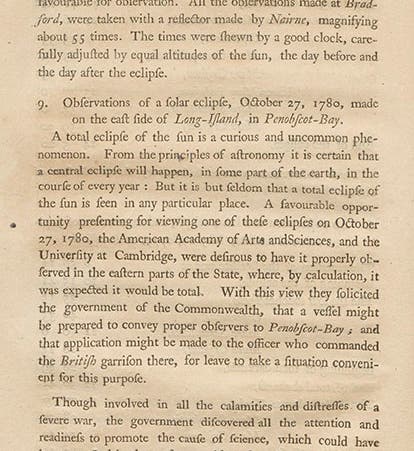Scientist of the Day - Samuel Williams
Samuel Williams, a colonial American astronomer, was born Apr. 23, 1743. Williams was the third Hollis Professor of Natural Philosophy at Harvard College, succeeding the latest of the many John Winthrop's that the colonies managed to produce. In 1780, Williams led an expedition to Maine in 1780, to observe a total solar eclipse that had been predicted for the location of Penobscot Bay, about halfway up the Maine Coast. The most intriguing feature of the expedition is that this was during the Revolutionary War, and the British occupied Penobscot Bay. Willliams, rather amazingly, got permission from the British to undertake his expedition, the war notwithstanding.
The eclipse occurred right on schedule, on Oct. 27, but the prediction of totality was not borne out, because Penobscot Bay, on the maps available to the Harvard astronomer, was a half-degree (35 miles) too far south, so the path of totality went north of Williams’ location, and they never saw the solar corona. But Williams did observe something else, a ring of beads around the edge of the sun as it neared maximum darkness. This is a well-known phenomenon, called Baily's Beads, in honor of English astronomer Francis Baily, who saw them in 1836. We show here a modern photograph of Baily’s beads (third image)
However, Baily discovered them about 50 years after Williams published his observations, so they should really be called Williams' beads, if there were any kind of eponymic justice in the world. But of course there is not.
Williams published the results of his expedition in the very first volume of the Memoirs of the American Academy of Arts and Sciences (1780-83). We show here the title page of the volume, the first page of Williams' article, a detail of the page in which he describes Baily's beads; and a detail of the last page, where he comments without showing any irritation on the fact that their maps were half-a-degree off, so that much of their effort was wasted.
Our copy of the Memoirs of the Academy is of interest, because it was once the copy in the Library of the American Academy in Boston, until we bought that Library in 1946. So the volume we show here might well have been handled by Williams at some point. It is too bad he didn't write in the margin on p. 102: stupid damn map. Dr. William B. Ashworth, Jr., Consultant for the History of Science, Linda Hall Library and Associate Professor, Department of History, University of Missouri-Kansas City. Comments or corrections are welcome; please direct to ashworthw@umkc.edu.










